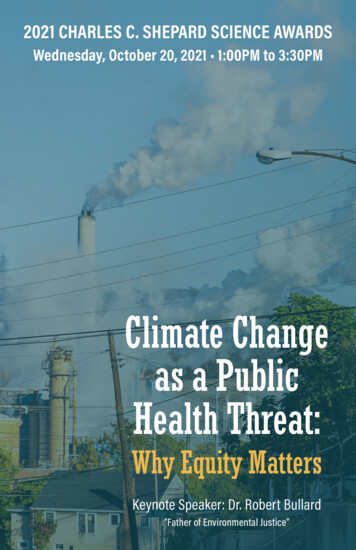
Transcription
2021 CHARLES C. SHEPARD SCIENCE AWARDSWednesday, October 20, 2021 1:00PM to 3:30PMClimate Changeas a PublicHealth Threat:Why Equity MattersKeynote Speaker: Dr. Robert Bullard“Father of Environmental Justice”
ii
SHEPARD AWARDS 2021Charles C. Shepard BiographyThe preeminent science awards of CDC/ATSDR, inaugurated in 1986, are named in honor of Charles C.Shepard, MD, the internationally recognized microbiologist who was chief of the Leprosy and RickettsiaBranch at CDC for more than 30 years, until his deathon February 18, 1985.Charles Carter Shepard was born in Ord, Nebraska,on December 18, 1914. He attended Stanford University(1932–1935) and then transferred to NorthwesternUniversity, where he received BS, MS, and MD degrees. In 1941, he joined theCommissioned Corps of the Public Health Service. From 1942 through 1948,he worked at the National Institutes of Health (NIH) in Bethesda, Maryland.While on sabbatical during 1948 through 1949, he worked in the laboratoryof Arne Tiselius in Uppsala, Sweden, and learned the new physical separation techniques that would revolutionize immunology and biochemistry.He returned to Bethesda for a year before moving to the Rocky MountainLaboratory, National Institute of Allergy and Infectious Diseases, NIH, inHamilton, Montana, to study various pathogenic bacteria and their phagesat the biochemical and ultrastructural levels. In 1953, he came to CDC,where he continued his outstanding work with rickettsiae and began hisdistinguished and definitive experiments with mycobacteria, culminatingin the cultivation of the leprosy bacillus, Mycobacterium leprae, in mice.His landmark article, “The Experimental Disease that Follows the Injectionof Human Leprosy Bacilli into Foot-Pads of Mice” (Journal of ExperimentalMedicine 1960;112:445–454), is still considered a classic in microbiology. Hisachievement made possible the large-scale evaluation of antibiotic efficacyand reduced testing time from several years to only months. It also pavedthe way for leprosy vaccine studies.Dr. Shepard made significant early contributions to the diagnosis, naturalhistory, and epidemiology of Rocky Mountain spotted fever; Q fever; andscrub, murine, and epidemic typhus. He was also codiscoverer (with JosephMcDade) of the Legionnaires’ disease bacterium (Legionella pneumophila)after the now famous outbreak of virulent pneumonia in Philadelphia in 1976.Dr. Shepard received numerous awards, among them the Gorgas Medal(1962), the Kimble Methodology Award (1962), the Philip R. Edwards Award(1964), the World Leprosy Day Award (1970), and the first CDC Medal ofExcellence (1977).1
He also received the HEW Distinguished Service Medal (1978), the RaolFolleraux Award (1978), and the Richard and Hinda Rosenthal Award (1979).He was active in multiple professional organizations, including the ArmedForces Epidemiologic Board Commission on Rickettsial Diseases, the WHOImmunology of Leprosy Program, the WHO Advisory Panel on Leprosy, theHeiser Program for Research in Leprosy, and the Leprosy Research Council,which he chaired. He was also involved in many editorial activities, havingserved on the board of directors of the International Journal of Leprosy andas a frequent reviewer for numerous prestigious journals.Although Dr. Shepard’s contributions to science and public health wereprodigious, perhaps his greatest legacy is the influence he has had on theCDC scientists who have followed in his footsteps and have continued to findinspiration in the scientific integrity and excellence he has come to represent.2
AWARDS PROGRAMOctober 20, 2021 1:00 P.M.Charles C. Shepard Science Awards Zoom CeremonyWebinar ID: 160 312 5135Passcode: Shepard21!International numbers omeRebecca Bunnell, PhD, MEdCDC Director WelcomeRochelle P. Walensky, MD, MPHIntroduction of Keynote SpeakerRebecca Bunnell, PhD, MEd“Climate Change as a Public Health Threat: Why Equity Matters”Robert Bullard, PhD, MALive Q&A Session with Dr. Bullard, Moderated by Mrs. Susan LairdPresentation of the 2021 Charles C. Shepard Science AwardsJoanne Cono, MDAssessmentData Methods and Study DesignLaboratory SciencePrevention and ControlHealth Equity ScienceLifetime Scientific Achievement2020 Lifetime Scientific Achievement Award Winner — AcceptanceClosingDebra Houry, MD, MPHVideo: “Earthrise” by Amanda Gorman3
Keynote SpeakerRobert D. Bullard, PhD, MARobert D. Bullard is often described as the “father ofenvironmental justice.” From 2011–2016, he servedas the dean of the Barbara Jordan-Mickey LelandSchool of Public Affairs at Texas Southern University.Professor Bullard currently is distinguished professorof urban planning and environmental policy. Beforehis arrival at Texas Southern he was founding directorof the Environmental Justice Resource Center at ClarkAtlanta University. He received his PhD from Iowa State University. He is anaward-winning author of 18 books that discuss sustainable development,environmental racism, urban land use, industrial facility siting, communityreinvestment, housing, transportation, climate justice, disasters, emergencyresponse, community resilience, smart growth, and regional equity. He iscofounder of the HBCU Climate Change Consortium. Dr. Bullard is a proudU.S. Marine Corps veteran.He was featured by CNN in July 2007 as one of its People You Should Know,Bullard: Green Issue is Black and White. In 2008, Newsweek named himone of 13 Environmental Leaders of the Century. And that same year, Co-opAmerica (Now Green America) honored him with its Building EconomicAlternatives Award. In 2010, The Grio named him one of “100 Black HistoryMakers in the Making,” and the website Planet Harmony celebrated him asone of “Ten African American Green Heroes.”His book, Dumping in Dixie: Race, Class and Environmental Quality, is astandard text in the environmental justice field. Some of his other books areJust Sustainabilities: Development in an Unequal World; Highway Robbery:Transportation Racism and New Routes to Equity; The Quest for EnvironmentalJustice: Human Rights and the Politics of Pollution; Growing Smarter:Achieving Livable Communities, Environmental Justice, and Regional Equity;and The Black Metropolis in the Twenty-First Century: Race, Power, and thePolitics of Place. He is also coauthor of In the Wake of the Storm: Environment,Disaster and Race After Katrina and Toxic Wastes and Race at Twenty:1987–2007. His most recent books are Race, Place and Environmental Justiceafter Hurricane Katrina; Environmental Health and Racial Equity in the UnitedStates, and The Wrong Complexion for Protection.4
In 2013, Dr. Bullard was honored with the Sierra Club’s John Muir Award.He was the first African American to win the award. The following year,the club named its new Environmental Justice Award after Dr. Bullard. In2015, the Iowa State University Alumni Association named him its AlumniMerit Award recipient, an award that was also given to George WashingtonCarver in 1937. In 2017, the Children’s Environmental Health Networkpresented him with the Child Health Advocate Award. In 2018, the GlobalClimate Action Summit named Dr. Bullard one of 22 Climate Trailblazers. In2019, Apolitical named him one of the world’s 100 Most Influential Peoplein Climate Policy, Washington State University honored him with theWilliam Julius Wilson Award for the Advancement of Justice, and ClimateOne named him the recipient of the Stephen H. Schneider Award forOutstanding Climate Science Communication.In 2020, WebMD presented Dr. Bullard with its Health Heroes TrailblazerAward, and the United Nations Environment Program honored him withits Champions of the Earth Lifetime Achievement Award, the UN’s highestenvironmental honor, recognizing outstanding leaders from government,civil society, and the private sector whose actions have had a transformativeeffect on the environment.5
CHARLES C. SHEPARD SCIENCEPUBLICATION AWARD NOMINEESNominated by the Centers for Disease Control and Prevention and theAgency for Toxic Substances and Disease Registry (CDC/ATSDR) forthe 2021 Charles C. Shepard Science Awards, the nominated articleswere judged on scientific merit and the significance of their effect onthe CDC/ATSDR mission. The following is a complete citation and briefdescription of each article, listed by category and in alphabetical orderby the first author’s last name.6
AssessmentIbraheem S. Al-Tarawneh, Steven J. Wurzelbacher, and Stephen J. BertkeComparative Analyses of Workers’ Compensation Claim of Injury AmongTemporary and Permanent Employed Workers in OhioAmerican Journal of Industrial Medicine 2020;63(1):3–22The authors compared injury rates in temporary and permanent workers usingworkers’ compensation data. Injury and illness rates for the temporary servicesindustry are underestimated by the Bureau of Labor Statistics because they arecounted at the host employer site, rather than at the temporary agency. But inworkers’ compensation systems, injury and illness claims for temporary employees are linked to the temporary agency. Findings suggest temporary workershad higher rates of injury than permanent workers performing similar work.Melissa M. Arons, Kelly M. Hatfield, Sujan C. Reddy, Anne Kimball, Allison James,Jesica R. Jacobs, Joanne Taylor, Kevin Spicer, Ana C. Bardossy, Lisa P. Oakley,Sukarma Tanwar, Jonathan W. Dyal, Josh Harney, Zeshan Chisty, Jeneita M. Bell,Mark Methner, Prabasaj Paul, Christina M. Carlson, Heather P. McLaughlin,Natalie Thornburg, Suxiang Tong, Azaibi Tamin, Ying Tao, Anna Uehara,Jennifer Harcourt, Shauna Clark, Claire Brostrom-Smith, Libby C. Page,Meagan Kay, James Lewis, Patty Montgomery, Nimalie D. Stone, Thomas A. Clark,Margaret A. Honein, Jeffrey S. Duchin, John A. Jernigan, Public Health-Seattle,King County, and the CDC COVID-19 Investigation TeamPresymptomatic SARS-CoV-2 Infections and Transmission in aSkilled Nursing FacilityThe New England Journal of Medicine 2020;382(22):2081–2090Early field observations suggested COVID-19 spread rapidly in nursing homesdespite CDC-recommended infection control measures that focused on testingand isolating symptomatic residents. This paper presented strong evidence forthe role of presymptomatic shedding in driving COVID-19 transmission. Findingsled to a fundamental change in CDC’s approach to COVID-19 case detectionand prevention strategy.7
Kristina L. Bajema, Ryan E. Wiegand, Kendra Cuffe, Sadhna V. Patel,Ronaldo Iachan, Travis Lim, Adam Lee, Davia Moyse, Fiona P. Havers,Lee Harding, Alicia M. Fry, Aron J. Hall, Kelly Martin, Marjorie Biel,Yangyang Deng, William A. Meyer, III, Mohit Mathur, Tonja Kyle,Adi V. Gundlapalli, Natalie J. Thornburg, Lyle R. Petersen, and Chris EdensEstimated SARS-CoV-2 Seroprevalence in the U.S. as of September 2020JAMA Internal Medicine 2021;181(4):450–460Because seroprevalence surveys yield more accurate estimates of cumulativeinfection, this study used residual blood serum from commercial laboratoriesto estimate SARS-CoV-2 prevalence. The authors tested nearly 178,000 samples, finding that less than 10% of U.S. residents had detectable SARS-CoV-2antibodies. Findings suggest that before vaccine availability, most U.S. residentshad not been infected with the virus, highlighting the importance of continuedpublic health prevention measures to limit its spread and the urgent need foreffective vaccines.Stephen R. Benoit, Israel Hora, Francisco J. Pasquel, Edward W. Gregg,Ann L. Albright, and Giuseppina ImperatoreTrends in Emergency Department Visits and Inpatient Admissions forHyperglycemic Crises in Adults with Diabetes in the U.S., 2006–2015Diabetes Care 2020;43(5):1057–1064Diabetic ketoacidosis (DKA) and hyperglycemic hyperosmolar state (HHS) arepreventable metabolic complications of diabetes, which affects more than 30million U.S. residents. This paper reports national trends in DKA and HHS amongU.S. adults. It is the first comprehensive report to assess DKA and HHS trendsin emergency department and inpatient settings, removing the potential biasassociated with changes in hospital admission thresholds. Findings suggestDKA and HHS prevalence is increasing for all ages and both sexes.Robert Douglas Daniels and Stephen J. BertkeExposure-response Assessment of Cancer Mortality inStyrene-exposed BoatbuildersOccupational and Environmental Medicine 2020;77(10):706–712Styrene is a benzene derivative used in about 15,000 industrial plants, mostlyto manufacture polystyrene plastics and resins. Based on animal studies, butlimited evidence in humans, styrene is also a suspected carcinogen. This paperuses statistical methods and exposure data to examine relationships betweenstyrene exposure and cancer risk in a cohort of U.S. boatbuilders. Findingssuggest certain workplace styrene exposures pose a cancer risk that can bereduced through improved risk management practices.8
Karrie F. Downing, Naomi K. Tepper, Regina M. Simeone, Elizabeth C. Ailes,Michelle Gurvitz, Sheree L. Boulet, Margaret A. Honein, Penelope P. Howards,Anne M. Valente, and Sherry L. FarrAdverse Pregnancy Conditions Among Privately Insured Women with andWithout Congenital Heart DefectsCirculation: Cardiovascular Quality and Outcomes 2020;13(6):e006311About 1.4 million adults in the United States have a congenital heart defect(CHD). This paper examines CHDs as a risk factor during pregnancy for adverse cardiac and obstetric conditions. Women with CHDs were found to havesignificantly higher prevalence of 25 cardiac and obstetric conditions duringpregnancy compared to women without CHDs. The authors also examinedhow frequently the use of cardiac-related medications can harm embryos andfetuses and how effective echocardiograms can be for pregnant women.Heather C. Hamner and Latetia V. MooreDietary Quality Among Children from 6 Months to 4 Years,NHANES 2011–2016The American Journal of Clinical Nutrition 2020;111(1):61–69Evidence suggests that early dietary patterns can have a lasting effect onhealth. However, there are limited measures for assessing dietary qualityamong children under 2 years of age. This paper characterizes dietary qualityamong U.S. children ages 6 months to 4 years, overall and by select sociodemographic characteristics. Findings suggest the effectiveness of emphasizinghealthy eating even early in children’s lives. Also, efforts may need to focus onchildren from households with lower incomes and education levels.S. Jane Henley, Cheryll C. Thomas, Denise Riedel Lewis, Elizabeth M. Ward,Farhad Islami, Manxia Wu, Hannah K. Weir, Susan Scott, Recinda L. Sherman,Jiemin Ma, Betsy A. Kohler, Kathleen Cronin, Ahmedin Jemal, Vicki B. Benard,and Lisa C. RichardsonAnnual Report to the Nation on the Status of Cancer, Part II: ProgressToward Healthy People 2020 Objectives for 4 Common CancersCancer 2020;126(10):2250–2266This paper measured progress toward Healthy People 2020 goals related tofour common cancers (lung, colorectal, female breast, and prostate), whichmake up almost half of all cancer deaths. The authors also examined differencesby sociodemographic characteristics such as sex, race, ethnicity, educationalattainment, and health insurance status. Despite progress during the pastdecade, findings suggest the need to reduce disparities in cancer screeningand in certain risk behaviors such as smoking, physical inactivity, and excessivealcohol consumption.9
Megan G. Hofmeister, Jian Xing, Monique A. Foster, Ryan J. Augustine,Cole Burkholder, Jim Collins, Shannon McBee, Erica D. Thomasson,Douglas Thoroughman, Mark K. Weng, and Philip R. SpradlingFactors Associated with Hepatitis A Mortality During Person-to-PersonOutbreaks: A Matched Case-Control Study—United States, 2016–2019Hepatology 2020;74(1):28–40Hepatitis A is a vaccine-preventable disease, but beginning in 2016, the UnitedStates has experienced outbreaks unprecedented since before hepatitisvaccines were developed. The authors conducted a matched case-controlstudy analyzing secondary data to identify and assess factors associated withdeath resulting from hepatitis A. The study identified patient characteristicsthat can guide clinical decision making and inform new Advisory Committeeon Immunization Practices hepatitis A vaccination recommendations.Jean Y. Ko, Melissa L. Danielson, Machell Town, Gordana Derado,Kurt J. Greenlund, Pam Daily Kirley, Nisha B. Alden, Kimberly Yousey-Hindes,Evan J. Anderson, Patricia A. Ryan, Sue Kim, Ruth Lynfield, Salina M. Torres,Grant R. Barney, Nancy M. Bennett, Melissa Sutton, H. Keipp Talbot,Mary Hill, Aron J. Hall, Alicia M. Fry, Shikha Garg, Lindsay Kim, andthe COVID-NET Surveillance TeamRisk Factors for Coronavirus Disease 2019 (COVID-19)-AssociatedHospitalization: COVID-19-Associated Hospitalization SurveillanceNetwork and Behavioral Risk Factor Surveillance SystemClinical Infectious Diseases 2021;72(11):e695–e703Early studies identified people with COVID-19 as usually older with underlyingmedical conditions. However, why these characteristics were more commonremained unclear. This paper investigated risk factors associated with COVID19-associated hospitalization by combining two data sources—the CoronavirusDisease 2019-Associated Hospitalization Surveillance and the Behavioral RiskFactor Surveillance System to derive population estimates. It provided seminalevidence for informing the COVID-19 risk categorizations. Findings informed riskcommunication as part of the COVID-19 emergency response.10
Ryan F. LeBouf, Brie Hawley Blackley, Alyson R. Fortner, Marcia Stanton,Stephen B. Martin, Caroline P. Groth, Tia L. McClelland, Matthew G. Duling,Dru A. Burns, Anand Ranpara, Nicole Edwards, Kathleen B. Fedan,Rachel L. Bailey, Kristin J. Cummings, Randall J. Nett, Jean Cox-Ganser,and M. Abbas VirjiExposures and Emissions in Coffee Roasting Facilities and Cafes: Diacetyl,2,3-Pentanedione, and Other Volatile Organic CompoundsFrontiers in Public Health 2020;8:561740Inhaling diacetyl has been associated with obliterative bronchiolitis, a severelung disease that can scar the airways. The authors investigated the healtheffects of exposure to diacetyl, 2,3-pentanedione, and other volatile organiccompounds at 17 coffee roasting and packaging facilities, including 10 cafés.Findings suggest grinding and flavoring coffee were the main tasks associated with elevated exposures. They further concluded that controlling emissionsat grinding machines and flavoring areas might be the best way to reduceworker exposures.Nilay McLaren, Adriana Lopez, Sarah Kidd, John X. Zhang, W. Allan Nix,Ruth Link-Gelles, Adria Lee, and Janell A. RouthCharacteristics of Patients with Acute Flaccid Myelitis,United States, 2015–2018Emerging Infectious Diseases 2020;26(2)212–219Acute flaccid myelitis (AFM) is a life-threatening neurologic condition thatmostly affects children and can lead to permanent paralysis. In 2014, an unusualAFM cluster in children was identified in Colorado. The authors compared thecharacteristics of AFM cases in peak and nonpeak years to determine causes.Their findings suggest rates of enterovirus (EV) infections, specifically enterovirus D-68, were greater during peak years and supports EV-D68 as a leadingtrigger of a new biennial epidemiologic pattern for AFM.Stephanie C. Melkonian, Hannah K. Weir, Melissa A. Jim, Bailey Preikschat,Donald Haverkamp, and Mary C. WhiteIncidence of and Trends in the Leading Cancers with Elevated IncidenceAmong American Indian and Alaska Native Populations, 2012–2016American Journal of Epidemiology 2021;190(4)528–538In this paper, excess incidence of cancers was found in American Indian/Alaska Native populations for three of the leading causes of cancer death(female breast, colorectal, and lung and bronchus) as well as liver, stomach,and kidney cancers across most regions. The authors corrected for racialmisclassification by comparing information with the Indian Health Servicepatient registration database. This approach to understanding health disparities by region can help identify social determinants of health, includingaccess to care and built environments.11
Martha L. Ospina, Van T. Tong, Maritza Gonzalez, Diana Valencia,Marcela Mercado, Suzanne M. Gilboa, Andrea J. Rodriguez, Sarah C. Tinker,Angelica Rico, Christina M. Winfield, Lissethe Pardo, Jennifer D. Thomas,Greace Avila, Julie M. Villanueva, Sara Gomez, Denise J. Jamieson,Franklyn Prieto, Dana Meaney-Delman, Oscar Pacheco, and Margaret A. HoneinZika Virus Disease and Pregnancy Outcomes in ColombiaThe New England Journal of Medicine 2020;383(6):537–545Congenital Zika virus infection causes serious defects of the brain and eyeamong newborns. The authors used data from two national surveillancesystems in Colombia to characterize Zika virus disease (ZVD) and pregnancyoutcomes, including brain and eye defects, during the 2015–2016 Zika virusoutbreak. The paper described the geographic distribution of ZVD and Zikaassociated brain and eye abnormalities. Findings describe the effect of theoutbreak on pregnancy and birth outcomes in Colombia.Lakshmi Panagiotakopoulos, Natalie L. McCarthy, Naomi K. Tepper,Elyse O. Kharbanda, Heather S. Lipkind, Gabriela Vazquez-Benitez,David L. McClure, Victoria Greenberg, Darios Getahun, Jason M. Glanz,Allison L. Naleway, Nicola P. Klein, Jennifer C. Nelson, and Eric S. WeintraubEvaluating the Association of Stillbirths After Maternal Vaccination in theVaccine Safety DatalinkObstetrics and Gynecology 2020;136(6):1086–1094The Advisory Committee on Immunization Practices recommends pregnantwomen receive vaccines against influenza, tetanus, diphtheria, and pertussisduring each pregnancy. This matched case-control study used data from theVaccine Safety Datalink, a collaboration between CDC and eight healthcare systems, to determine whether vaccines given in pregnancy were associatedwith stillbirth. The authors’ findings should reassure healthcare providers tocontinue recommending Tdap and influenza vaccines during pregnancy.Amanda B. Payne, Jason M. Mehal, Christina Chapman, Dana L. Haberling,Lisa C. Richardson, Christopher J. Bean, and W. Craig HooperTrends in Sickle Cell Disease-related Mortality in theUnited States, 1979 to 2017Annals of Emergency Medicine 2020;76(3S):S28–S36Sickle cell disease (SCD) is an inherited blood disorder associated with complications such as stroke, pulmonary disease, and impaired renal functionthat increase the risk of early death. This paper used national death certificate data to investigate trends in SCD-related deaths in the United States.Understanding which SCD complications are associated with the highest proportion of SCD-related deaths will help develop new clinical and public healthstrategies to improve health outcomes among people who have SCD.12
Audrey F. Pennington, Lyudmyla Kompaniyets, April D. Summers,Melissa L. Danielson, Alyson B. Goodman, Jennifer R. Chevinsky,Leigh Ellyn Preston, Lyna Z. Schieber, Gonza Namulanda, Joseph Courtney,Heather M. Strosnider, Tegan K. Boehmer, William R. MacKenzie,James Baggs, and Adi V. GundlapalliRisk of Clinical Severity by Age and Race/Ethnicity Among AdultsHospitalized for COVID-19—United States, March–September 2020Open Forum Infectious Diseases 2020;8(2):ofaa638Identifying demographic factors that increase risk of clinical severity forCOVID-19 helps allocate prevention resources and prioritize vaccine delivery.The authors used electronic health record data from more than 180,000 patientsdiagnosed with COVID-19 to describe the risk of severity by age and race/ethnicity among adults hospitalized in the United States. They also exploredwhether the effect of age on clinical severity differs by race/ethnicity. Findingssuggest the association between age and severity differs by race/ethnicity.Jin Qin, Mona Saraiya, Gladys Martinez, and George F. SawayaPrevalence of Potentially Unnecessary Bimanual Pelvic Examinations andPapanicolaou Tests Among Adolescent Girls and Young Women Aged 15–20Years in the United StatesJAMA Internal Medicine 2020;180(2):274–280Early screening tests often detect cancers when treatment is likely to workbest, but almost all such tests have some risk of adverse effects. This studyshowed that the bimanual pelvic examination (BPE) and Pap tests of womenyounger than 21 years pose such risks. The authors found that many youngwomen had received unnecessary BPEs and Pap tests. Results suggest clinicalpractices like pelvic examinations and Pap tests during routine STI screeningscontinue even though guidelines have changed.Laura A. S. Quilter, Alex de Voux, Rachel M. Amiya, Erin Davies, Robin R. Hennessy,Roxanne P. Kerani, Robbie Madera, James Matthias, Victoria M. Pearson, Jaime K.Walters, Craig Wilson, Sarah Kidd, and Elizabeth TorronePrevalence of Self-reported Neurologic and Ocular Symptoms inEarly Syphilis CasesClinical Infectious Diseases 2021;72(6):961–967Syphilis rates in the United States continue to increase, with more than 129,000cases reported in 2019 alone. And although neurologic and ocular complications of syphilis are rare, their numbers are likely to increase along with theincreasing rate of syphilis infections. This paper characterizes the burden ofself-reported neurologic and ocular symptoms among early syphilis cases infive U.S. jurisdictions. Findings can be used to target public health action suchas healthcare provider education, training, and clinic protocols.13
John Rossow, Belinda Ostrowsky, Eleanor Adams, Jane Greenko,Robert McDonald, Snigdha Vallabhaneni, Kaitlin Forsberg, Stephen Perez,Todd Lucas, Karen A. Alroy, Kara Jacobs Slifka, Maroya Walters,Brendan R. Jackson, Monica Quinn, Sudha Chaturvedi, Debra Blog,and the New York Candida auris Investigation WorkgroupFactors Associated with Candida auris Colonization and Transmission inSkilled Nursing Facilities with Ventilator Units, New York, 2016–2018Clinical Infectious Diseases 2021;72(11):e753–e760High-acuity long-term care facilities are central to the transmission of Candidaauris in the United States. But why some residents become infected by this multidrug-resistant fungus while others do not remains unclear. This paper proposes a new approach to contact tracing that will help prevent invasive infections.The authors found that roommates are at no greater risk of transmission thanothers on the ward, and patients on wards without infected patients were not atmeaningful risk.J. Erin Staples, Daniel M. Pastula, Amanda J. Panella, Ingrid B. Rabe, Olga I Kosoy,William L. Walker, Jason O. Velez, Amy J. Lambert, and Marc FischerInvestigation of Heartland Virus Disease Throughout theUnited States, 2013–2017Open Forum Infectious Diseases 2020;7(5):ofaa125Heartland virus (HRTV) was discovered in the blood of two hospitalized patientsin Missouri suspected of having a tick-borne illness. This paper describes howthe authors characterized the epidemiology, clinical features, risk factors, andgeographic distribution of this new pathogen. They also developed and validated tests to identify new infections, uncovering additional cases. Findings havebeen used to update CDC guidance for who should receive HRTV testing andwhat tests should be used.William Stephens, Grete E. Wilt, Erica Adams Lehnert,Noelle-Angelique M. Molinari, and Tanya Telfair LeBlancA Spatial and Temporal Investigation of Medical Surge in Dallas–Fort WorthDuring Hurricane Harvey, Texas 2017Disaster Medicine and Public Health Preparedness 2020;14(1):111–1182020 saw a record number of storms make landfall in the United States, allduring a global pandemic. This study investigated how well emergency departments in Dallas–Fort Worth area hospitals coped with the surge in emergencydepartment visits during Hurricane Harvey in 2017. Accurate means of assessingthe impact of public health emergencies on hospitals will improve the preparedness of coastal states during similar large public health contingencies. Theauthors’ assessment validates a methodology needed in public health.14
Elizabeth A. Swedo, Steven A. Sumner, Sietske de Fijter, Luke Werhan,Kirkland Norris, Jennifer L. Beauregard, Martha P. Montgomery,Erica B. Rose, Susan D. Hillis, and Greta M. MassettiAdolescent Opioid Misuse Attributable to Adverse Childhood ExperiencesThe Journal of Pediatrics 2020;224:102–109.e3Youth have not been spared the harm of the opioid epidemic. In fact, overdosedeaths among adolescents are at an all-time high. This study describes thenature of adverse childhood experiences (ACEs) in the adolescent populationand their relationship to opioid abuse. ACEs—such as neglect, experiencing orwitnessing violence, or having a family member attempt or die by suicide—were found to be an important risk factor for adult opioid misuse.Adam S. Vaughan, Linda Schieb, and Michele CasperHistoric and Recent Trends in County-level Coronary Heart Disease DeathRates by Race, Gender, and Age Group, United States, 1979–2017PLOS One 2020;15(7):e0235839Heart disease is the leading cause of death and disability in the United States.Using national vital statistics mortality data, the authors examined 39 years(1979–2017) of changing county-level coronary heart disease (CHD) death ratesby age group, race, and gender. The study details the national surveillance ofcardiovascular disease and documents health inequities. Findings point to theneed for greater surveillance of CHD, including its incidence, risk factors, andcorresponding social determinants.Angela K. Werner, Emilia H. Koumans, Kevin Chatham-Stephens,Phillip P. Salvatore, Christina Armatas, Paul Byers, Charles R. Clark, Isaac Ghinai,Stacy M. Holzbauer, Kristen A. Navarette, Melissa L. Danielson, Sascha Ellington,Erin D. Moritz, Emily E. Petersen, Emily A. Kiernan, Grant T. Baldwin, Peter Briss,Christopher M. Jones, Brian A. King, Vikram Krishnasamy, Dale A. Rose,Sarah Reagan-Steiner, and the Lung Injury Response Mortality Working GroupHospitalizations and Deaths Associated with EVALIThe New England J
Charles Carter Shepard was born in Ord, Nebraska, on December 18, 1914. He attended Stanford University (1932–1935) and then transferred to Northwestern University, where he received BS, MS, and MD degrees. In 1941, he joined the Commissioned Co


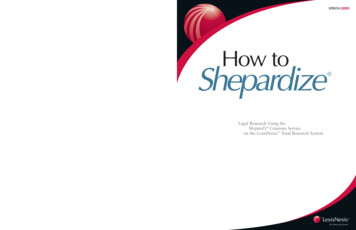
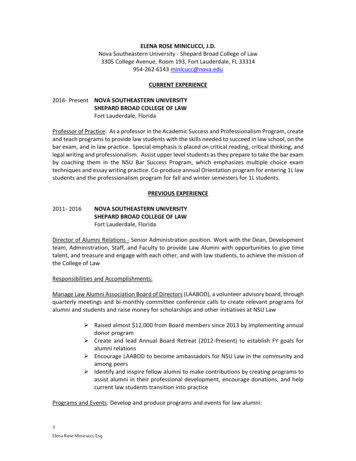
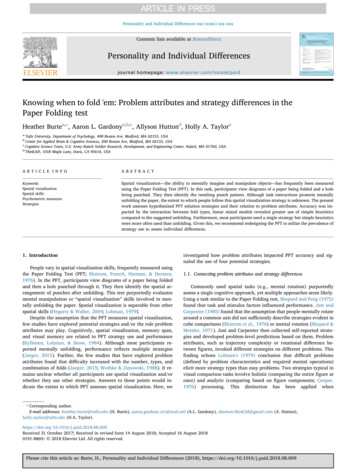


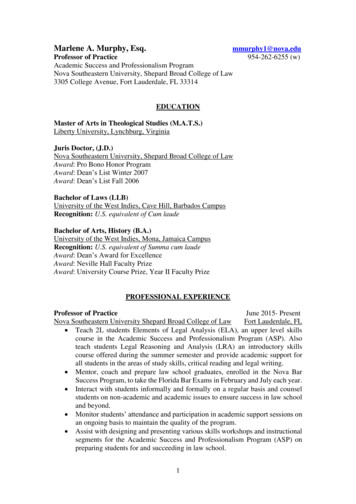


![The Book of the Damned, by Charles Fort, [1919], at sacred .](/img/24/book-of-the-damned.jpg)